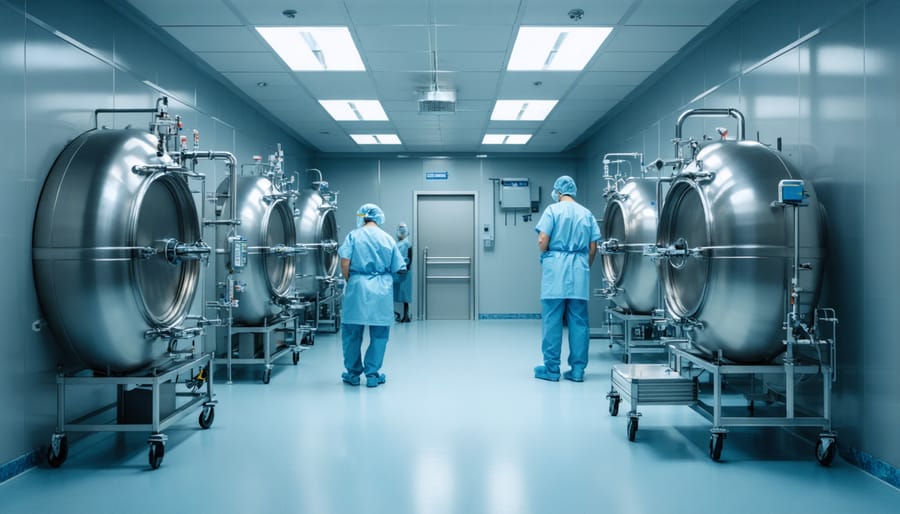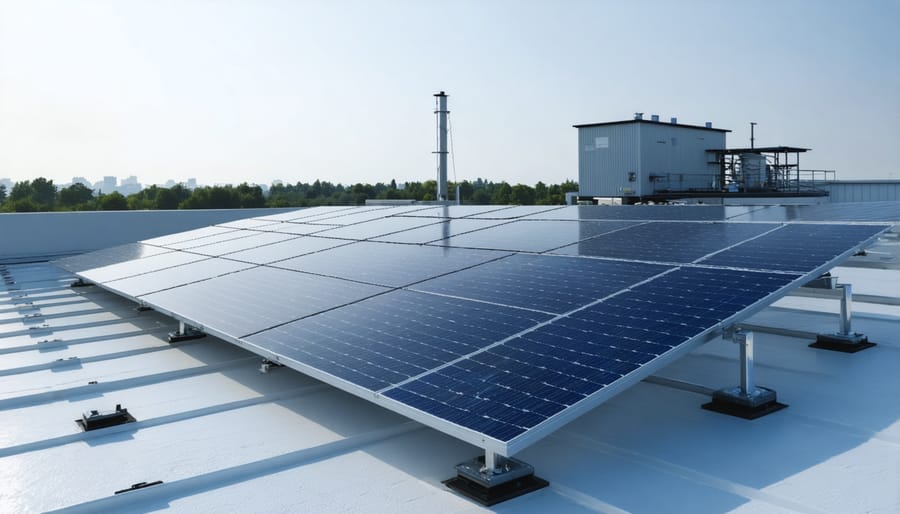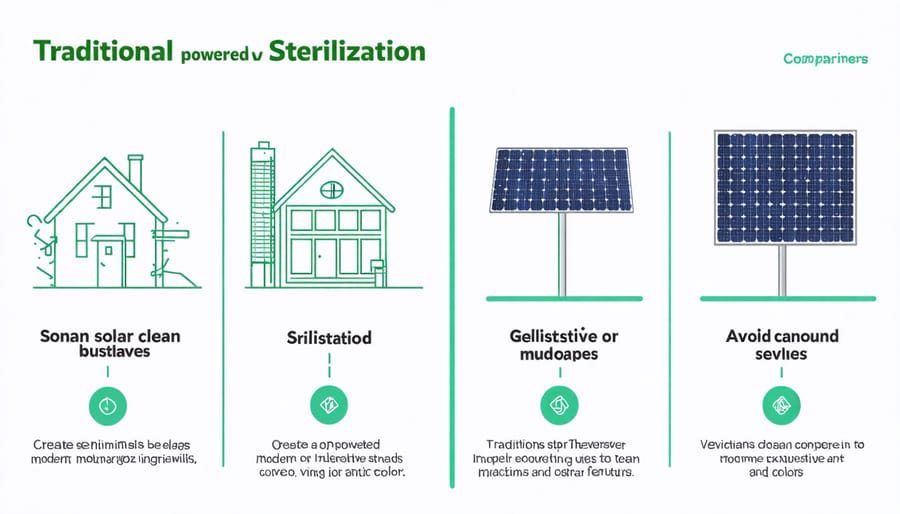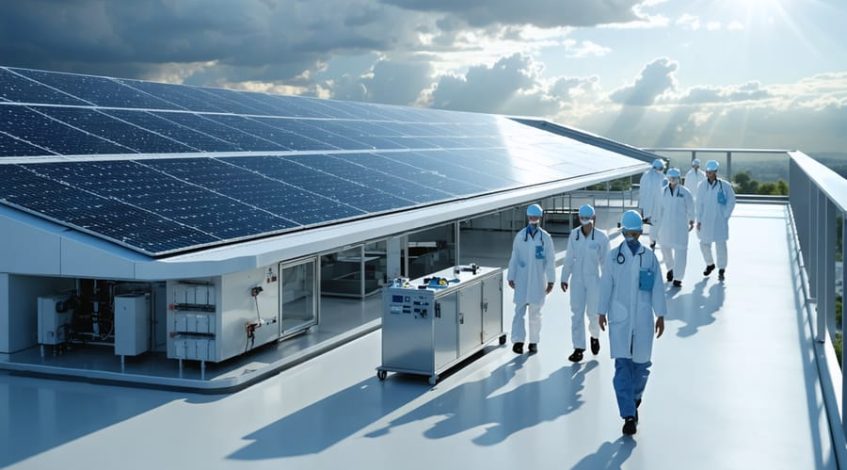Medical sterilization plants stand at the forefront of healthcare facility innovation, where the convergence of sterile processing requirements and sustainable energy solutions creates unprecedented opportunities for operational efficiency. Building upon the remarkable history of solar energy, modern sterilization facilities are revolutionizing their operations through integrated solar power systems, reducing energy costs by up to 60% while maintaining stringent sterilization standards.
These facilities, processing millions of medical devices annually, require consistent, high-temperature steam generation and precise climate control – making them ideal candidates for solar energy integration. Advanced thermal collectors and photovoltaic arrays now power critical sterilization processes, from autoclave operations to water heating systems, while sophisticated energy storage solutions ensure uninterrupted service during non-peak solar hours.
For healthcare administrators and facility managers, this transformation represents not just environmental responsibility but substantial financial advantages, with typical ROI periods of 4-6 years and operational lifespans exceeding two decades. The implementation of solar-powered sterilization systems demonstrates how cutting-edge renewable technology can enhance both operational reliability and bottom-line performance in critical healthcare infrastructure.
Understanding Medical Sterilization Plants

Traditional Sterilization Methods and Energy Consumption
Traditional medical sterilization methods rely heavily on energy-intensive processes to ensure the complete elimination of pathogens and microorganisms. Steam sterilization, commonly known as autoclaving, typically operates at temperatures between 121-134°C and requires significant electricity consumption to maintain these high temperatures for extended periods.
A standard medical autoclave consumes approximately 65-75 kWh per cycle, with larger facilities running multiple cycles daily. Dry heat sterilization, another common method, operates at even higher temperatures (160-170°C) and longer cycle times, resulting in energy consumption of up to 100 kWh per cycle.
Chemical sterilization processes, while less energy-intensive in terms of heat requirements, still demand considerable power for ventilation systems and safety controls. Ethylene oxide (EtO) sterilization, widely used for heat-sensitive materials, requires precise temperature control and extensive aeration cycles, consuming approximately 40-50 kWh per cycle.
These energy requirements translate to substantial operational costs, with medium-sized sterilization facilities often spending $15,000-$20,000 monthly on energy expenses. This significant energy footprint has prompted many facilities to explore more sustainable alternatives and energy-efficient solutions.
The Need for Sustainable Alternatives
Traditional medical sterilization processes rely heavily on energy-intensive methods that contribute significantly to healthcare facilities’ carbon footprint and operational costs. These conventional systems typically consume substantial amounts of electricity and often utilize ethylene oxide, which poses environmental and health risks. The increasing pressure to reduce greenhouse gas emissions, coupled with rising energy costs, has prompted healthcare facilities to explore sustainable energy solutions for their sterilization needs.
Current sterilization methods can account for up to 15% of a hospital’s total energy consumption, leading to substantial utility bills and environmental impact. Additionally, the maintenance and compliance costs associated with traditional sterilization equipment continue to rise, affecting healthcare facilities’ bottom line. The dependence on fossil fuels not only contributes to environmental degradation but also exposes facilities to energy price volatility and supply chain disruptions.
These challenges underscore the urgent need for innovative, cost-effective alternatives that can maintain rigorous sterilization standards while reducing environmental impact and operating expenses. Healthcare facilities must adapt to meet increasingly stringent environmental regulations while ensuring the highest levels of medical safety and compliance.
Solar Energy Integration in Medical Sterilization

Solar-Powered Sterilization Technology
Solar-powered sterilization technology represents a significant advancement in sustainable medical facility operations, combining renewable energy with critical healthcare needs. These systems typically integrate high-efficiency photovoltaic panels with specialized sterilization equipment, providing a reliable power source for autoclave operations and other sterilization processes.
Modern solar sterilization installations feature advanced inverter systems that convert DC power from solar panels into stable AC power, ensuring consistent operation of sterilization equipment. Energy storage solutions, such as lithium-ion battery banks, maintain operational continuity during non-peak solar hours and cloudy conditions.
A typical installation requires approximately 50-75 kW of solar capacity to power a medium-sized medical sterilization facility, depending on operational demands. These systems often incorporate smart monitoring technology that optimizes energy distribution between sterilization equipment, storage systems, and facility operations.
Recent implementations have demonstrated significant cost benefits. For example, a 200-bed hospital in California reported a 40% reduction in sterilization energy costs after installing a solar-powered system. The facility achieved ROI within 4.5 years, while maintaining compliance with all medical sterilization standards.
Key components of these systems include:
– High-efficiency solar panels with medical-grade power conditioning
– Automated load management systems
– Redundant power controls for emergency situations
– Real-time monitoring and reporting capabilities
– Integration with existing facility management systems
These installations typically achieve 95% uptime while reducing carbon emissions by up to 70% compared to traditional grid-powered systems.
Energy Storage Solutions
Reliable power supply is crucial for medical sterilization facilities, where any interruption can compromise patient safety and operational efficiency. Modern energy storage solutions provide the necessary backup power and stability required for continuous operation.
Advanced lithium-ion battery systems, typically ranging from 100kWh to 1MWh capacity, form the backbone of these facilities’ power infrastructure. These systems are designed to maintain critical operations during grid outages and optimize energy consumption during peak demand periods. Implementing a multi-tiered approach, facilities often combine battery storage with uninterruptible power supply (UPS) systems and emergency generators.
The integration of smart battery management systems enables real-time monitoring and predictive maintenance, ensuring optimal performance and longevity of storage units. These systems can automatically switch between power sources, maintaining stable voltage and frequency levels essential for sensitive sterilization equipment.
Modern storage solutions also support demand response programs, allowing facilities to reduce operational costs by storing energy during off-peak hours and utilizing it during high-demand periods. This approach typically results in 15-30% reduction in energy costs while ensuring uninterrupted sterilization processes.
For maximum reliability, facilities often implement redundant storage systems with N+1 configuration, ensuring backup power availability even during maintenance operations or unexpected system failures.
System Monitoring and Maintenance
Effective system monitoring and maintenance are crucial for ensuring the optimal performance and safety of medical sterilization plants. Regular monitoring protocols should include daily checks of sterilization parameters, including temperature, pressure, and cycle duration. Facility managers must implement a comprehensive maintenance schedule that encompasses both preventive and predictive maintenance strategies.
Key monitoring requirements include continuous tracking of steam quality, recording of sterilization cycle data, and verification of proper equipment function through biological and chemical indicators. Advanced monitoring systems should be equipped with real-time alerts and data logging capabilities to ensure compliance with regulatory standards and maintain process validation.
Maintenance protocols should address three primary areas: mechanical systems, control systems, and safety features. Regular calibration of instruments, inspection of gaskets and seals, and testing of safety valves are essential components of the maintenance program. Documentation of all maintenance activities, including repairs and replacements, must be maintained for regulatory compliance and quality assurance purposes.
Staff training plays a vital role in system monitoring and maintenance. Personnel should be properly trained in equipment operation, troubleshooting procedures, and emergency protocols. Regular audits of monitoring systems and maintenance records help identify potential issues before they impact operations.
A well-structured preventive maintenance program typically includes quarterly comprehensive inspections, annual validation testing, and systematic replacement of wear components based on manufacturer recommendations and usage patterns.

Cost Analysis and ROI
Initial Investment vs. Long-term Savings
The implementation of solar energy systems in medical sterilization plants requires careful consideration of initial capital expenditure against future returns. While the upfront costs typically range from $500,000 to $2 million depending on facility size and energy requirements, these investments are offset by substantial long-term energy cost savings and operational benefits.
A comprehensive cost analysis reveals that most facilities achieve break-even within 5-7 years of installation. The initial investment encompasses solar panel arrays, inverters, energy storage systems, and integration with existing sterilization equipment. However, facilities can expect to reduce their energy costs by 40-60% annually, with some achieving even higher savings in regions with optimal solar conditions.
Modern medical sterilization plants implementing solar solutions typically report annual energy savings of $75,000 to $150,000, depending on facility size and local utility rates. These figures don’t include additional benefits such as government incentives, tax credits, and renewable energy certificates, which can significantly improve the return on investment.
Furthermore, the longevity of solar installations, with panels typically warranted for 25 years, ensures sustained cost benefits well beyond the initial payback period. When factoring in rising traditional energy costs and increasing environmental regulations, the financial advantages of solar integration become even more compelling for medical sterilization facilities.
Available Incentives and Funding Options
Medical sterilization facilities can access various government incentives and funding options to support their transition to solar energy systems. The Federal Investment Tax Credit (ITC) allows facilities to deduct up to 30% of their solar installation costs from federal taxes. Additionally, Modified Accelerated Cost Recovery System (MACRS) enables businesses to depreciate solar assets over a five-year period, significantly improving ROI.
Many states offer specific renewable energy grants and rebates for healthcare facilities. For instance, the Healthcare Energy Efficiency Program (HEEP) provides matching funds of up to 50% for energy efficiency upgrades, including solar installations. Facilities can also leverage Property Assessed Clean Energy (PACE) financing, which allows them to fund solar projects through property tax assessments with no upfront costs.
Green lending programs from major financial institutions offer competitive interest rates for solar projects in healthcare settings. The USDA Rural Energy for America Program (REAP) provides grants and loan guarantees specifically for rural healthcare facilities implementing renewable energy systems.
Public-private partnerships and power purchase agreements (PPAs) present alternative financing solutions, allowing facilities to benefit from solar energy without significant capital investment. Environmental Sustainability Bonds (ESBs) are another emerging funding option, particularly suitable for larger medical sterilization operations seeking to demonstrate their commitment to sustainability while accessing favorable financing terms.
Case Study: Success Stories in Solar Sterilization
The adoption of solar-powered medical sterilization facilities has proven successful across various healthcare settings worldwide. One notable example is the Solar Autoclave Project in rural India, implemented in 2019, which serves a network of 15 medical clinics. This facility reduced energy costs by 75% while maintaining consistent sterilization standards for medical instruments and supplies.
In Kenya, the Kisumu Regional Hospital integrated a hybrid solar sterilization system in 2020, combining photovoltaic panels with thermal collectors. The facility processes approximately 200 kg of medical equipment daily, achieving energy independence during daylight hours and reducing operational costs by 60% annually. The system’s payback period was realized within 2.5 years, demonstrating strong financial viability.
The Mount Sinai Medical Center in California presents another compelling case study. Their 2021 solar sterilization upgrade incorporated advanced tracking systems and energy storage solutions. The facility now processes over 500 kg of medical supplies daily while reducing carbon emissions by 85%. The project’s success led to its replication across three additional facilities in the region.
In Mexico, the Universidad Nacional Autónoma’s medical research facility pioneered a concentrated solar power system for sterilization in 2018. This innovative approach maintains temperatures of 121°C consistently during peak hours, meeting all regulatory requirements while reducing energy dependency on the grid by 90%.
These implementations share common success factors: careful planning, strategic placement of solar collectors, integration with existing systems, and comprehensive staff training programs. ROI calculations from these facilities indicate average payback periods of 3-4 years, with subsequent operational cost reductions ranging from 50-80%. The facilities also report enhanced reliability during power outages and improved compliance with sustainability initiatives, demonstrating the practical viability of solar sterilization in modern healthcare settings.
Solar-powered medical sterilization represents a significant advancement in sustainable healthcare infrastructure, offering multiple benefits that extend beyond environmental impact. The integration of solar energy into sterilization processes has demonstrated substantial cost savings, with facilities reporting up to 60% reduction in operational expenses over traditional energy sources. This technology has proven particularly valuable in remote and developing regions, where reliable grid power may be inconsistent or unavailable.
Looking ahead, the future of solar-powered medical sterilization appears promising. Technological improvements in solar panel efficiency and energy storage solutions continue to enhance system reliability and effectiveness. Industry experts project that by 2030, solar-powered sterilization systems could become standard equipment in new medical facilities worldwide, driven by both environmental regulations and economic advantages.
The scalability of these systems, combined with decreasing installation costs, makes them an increasingly attractive option for healthcare facilities of all sizes. As governments worldwide implement stricter environmental regulations and healthcare facilities face mounting pressure to reduce their carbon footprint, solar-powered sterilization presents a viable solution that aligns with both sustainability goals and operational requirements.
Investment in solar-powered medical sterilization technology today positions healthcare facilities at the forefront of sustainable healthcare practices while ensuring long-term operational efficiency and cost effectiveness. With continued technological advancement and growing adoption rates, this innovative approach to medical sterilization is set to play a crucial role in shaping the future of healthcare infrastructure.

